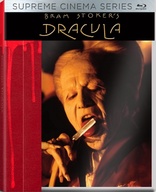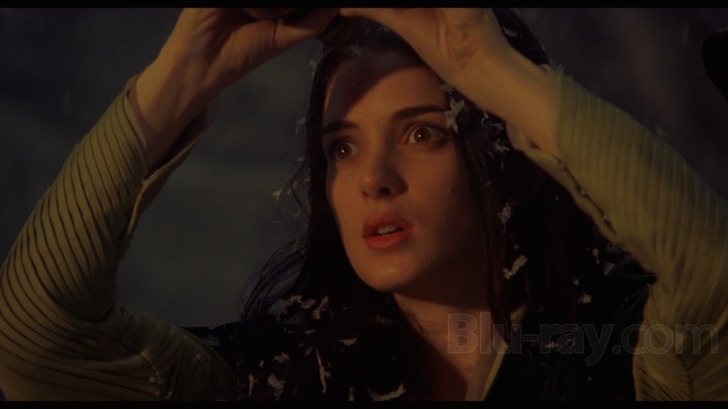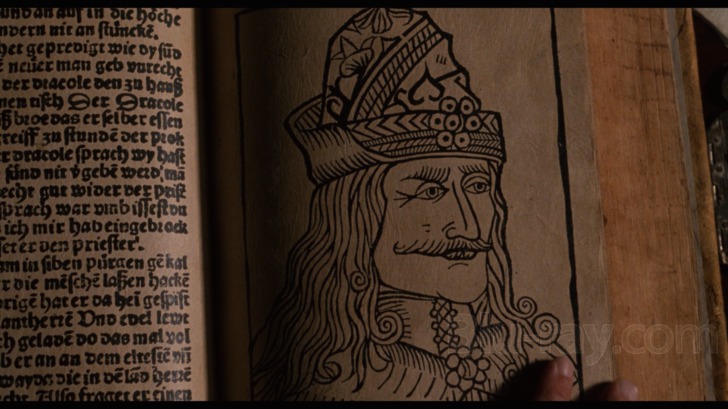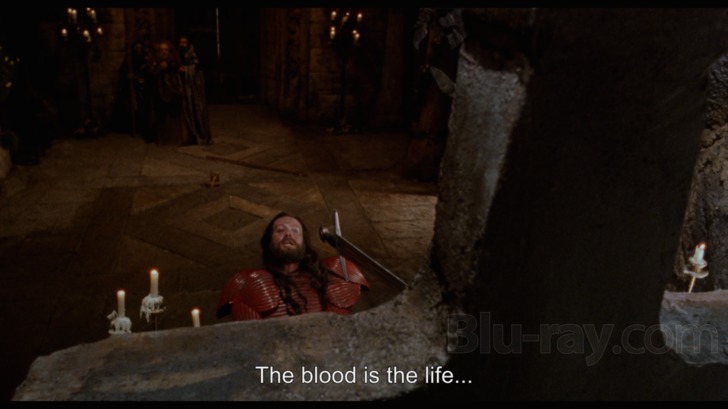Bram Stoker's Dracula Blu-ray Movie
HomeBram Stoker's Dracula Blu-ray Movie 
Supreme Cinema Series | Limited Edition / Blu-ray + UV Digital CopySony Pictures | 1992 | 127 min | Rated R | Oct 06, 2015

Movie rating
7.7 | / 10 |
Blu-ray rating
| Users | 4.8 | |
| Reviewer | 4.5 | |
| Overall | 4.7 |
Overview
Bram Stoker's Dracula (1992)
A young English lawyer, Jonathan Harker, is sent to a gloomy village in eastern Europe. He is captured and imprisoned by the undead vampire Dracula, who travels to London, inspired by a photograph of Harker's betrothed, Mina Murray. In Britain, Dracula begins a reign of seduction and terror, draining the life from Mina's closest friend, Lucy Westenra. Lucy's friends gather together to try to drive away Dracula and rescue Mina.
Starring: Gary Oldman, Winona Ryder, Anthony Hopkins, Keanu Reeves, Richard E. GrantDirector: Francis Ford Coppola
| Horror | Uncertain |
| Thriller | Uncertain |
| Period | Uncertain |
| Romance | Uncertain |
| Drama | Uncertain |
| Fantasy | Uncertain |
Specifications
Video
Video codec: MPEG-4 AVC
Video resolution: 1080p
Aspect ratio: 1.85:1
Original aspect ratio: 1.85:1
Audio
English: Dolby Atmos
English: Dolby TrueHD 7.1 (48kHz, 24-bit)
English: Dolby Digital 5.1 (640 kbps)
French: Dolby Digital 5.1 (448 kbps)
Spanish: Dolby Digital 5.1 (448 kbps)
Subtitles
English, English SDH, French, Spanish, Danish, Dutch, Finnish, Icelandic, Norwegian, Swedish, Turkish
Discs
50GB Blu-ray Disc
Single disc (1 BD)
UV digital copy
Playback
Region A (locked)
Review
Rating summary
| Movie | 5.0 | |
| Video | 4.5 | |
| Audio | 5.0 | |
| Extras | 4.0 | |
| Overall | 4.5 |
Bram Stoker's Dracula Blu-ray Movie Review
Reviewed by Martin Liebman October 2, 2015Cinema's longstanding love affair with the vampire seems as storied as any other, and as varied, too. The undead, creature of the night, bloodsucking subject has seen its share of classic, comedy, exploitative, reimagined, and trendy films over the decades, most all of them with some merit but few -- outside of those classics -- holding much real, meaningful value as cinema's most impressively artistic, emotionally satisfying, deeply meaningful, and profoundly thoughtful Vampire film, legendary Filmmaker Francis Ford Coppola's (the Godfather trilogy, Apocalypse Now) Bram Stoker's Dracula. A film that combines graceful moviemaking with a dark undercurrent, a story that blends deep romanticism with the superficial sins of the flesh, a picture that meshes intimate character study with bloody horrors, the film is a bonafide classic of the medium, one of the quintessential definitions of cinema as art and an enduring masterpiece that's nearly as wonderful as the novel on which it's based.

The costumes are the sets, the shadows speak volumes, the movie dazzles as a perfect example of cinema as art.
Young Solicitor Jonathan Harker (Keanu Reeves) travels from London to Transylvania to facilitate a deal for an enigmatic Count, Dracula (Gary Oldman), who is purchasing land in London, including Carfax Abbey. Harker, who is replacing his predecessor R. M. Renfield (Tom Waits) who is wasting away in a London insane asylum, knows not that his visit will forever shape the destinies of all around him. He's set to be married to Mina (Winona Ryder), a London socialite whom Dracula learns bears a striking resemblance to his centuries-dead bride Elisabeta, who committed suicide when she feared Dracula dead in battle. Following her death, Dracula renounced God and vowed to avenge her, and his time, it seems, has arrived. After closing the deal, Dracula leaves Harker imprisoned in his castle while he travels to London to meet Mina. He attacks and infects Mina's friend Lucy (Sadie Frost). Her suitors -- Dr. Jack Seward (Richard E. Grant), Quincey Morris (Billy Campbell), and Arthur Holmwood (Cary Elwes) -- hire the vampire hunter Abraham Van Helsing (Anthony Hopkins) to destroy the creature that turned Lucy and threatens Mina.
Bram Stoker's Dracula is essentially a love story and a revenge story, the tale of a man whose life is ravaged by the untimely death of his bride and his vengeful retribution against the light, or perhaps better said "goodness" and "innocence." The story intertwines a rebuke of faith with a craving for flesh and blood, but the film isn't so much concerned with those violent ends but rather why, and the means by which, the Dracula character reaches towards them. The narrative deals in a classic clash between good and evil, with the former in some ways flawed but the latter molded by the world's metaphorical darkness and an almost understandable, in some perverse way even sympathetic turn to that darkness when righteousness is repaid with torment. Dracula's pledge to renounce God, avenge his bride's death, and turn to evil is a classic motif that is here presented within the fearful prism of vampirism and the grisly, gritty world in which it exists.
Of course, that narrative -- simple in purpose, complex in execution -- is supported by a beautifully haunting production design. The film's story satisfies, but its support pieces are the unequivocal highlight and more than anything -- story, performances -- define the film. Coppola's ability to make such remarkable use of light and shadow not only as atmospheric support elements but as integral foreboding and foretelling elements immediately portends greatness for the film, and the steady manipulation of light and dark to the story's benefit is astounding as a necessary storytelling detail but also when considering the pure artistic merit it demonstrates. The supportive production design pieces -- particularly the film's costuming and its contrast against the sets -- are equally precise, both visually intoxicating and thematically essential. Victorian era London is positively sumptuous, but it's the dreary, shadowy, spine tingling, finely honed castle Dracula that dominates the film. It's here where Coppola captures the darkest essence of the movie and builds its foundational elements that will almost subconsciously prepare the audience for the film's shift to London which may represent a superficial tonal visual change but that emotionally maintains that same shadowy, dark dread that will follow it.
More, the film boasts fine performances, including from the much-maligned Keanu Reeves whose naiveté, hesitation, and uncertainty -- all of which he meets with a stoic, albeit seemingly feigned, outward confidence -- only seem to create a more sympathetic Jonathan Harker whom the audience can get behind as a victim of both the physical and emotional tolls his encounters with Dracula engender, both the physical torture and captivity and the straining relationship with Mina and what her involvement with Dracula means for them individually and as a couple. His fresh-faced take on the character is matched by Winona Ryder, whose own naiveté may not run so deep as her superficially focused friend Lucy but it certainly sets the stage for the character transformation that begins with Dracula's arrival in London. Anthony Hopkins impresses as Van Helsing -- offering probably the single best on-screen performance the character has yet enjoyed -- but it's Gary Oldman whose remarkable take on Dracula is a stunning achievement in acting. Oldman, though aided by makeup and wardrobe of varying degrees and styles, inhabits the character and emotes Dracula's emotional depth with a grace, persistence, and deeply rooted understanding of the character's inward complexities that define the figure more than any stroke of makeup or wardrobe choice, and certainly deeper than popular Dracula mythos. His is easily the finest work in the film and a critical centerpiece to a movie that gets everything right.
Bram Stoker's Dracula Blu-ray Movie, Video Quality 

Sony really cannot catch a break these days, and particularly with this release. The studio has returned to the well for one of its most popular
catalogue titles in Bram Stoker's Dracula and issued a hotly anticipated "Mastered in 4K" re-release following the hugely controversial first run Blu-ray that arrived on the scene almost eight years ago to the day in a
time in which the format was still in its infancy. That release's transfer was much maligned for, primarily, its color timing (despite apparent approval
from Director
Francis Ford Coppola himself; and that certainly wasn't the only example of a "director approved" transfer meeting with gross disapproval from
the Blu-ray community). This latest transfer presents the film with a superior image in nearly every way, offering significantly sharper and filmic
textures, hugely improved shadow depth and detail, and a more balanced color scheme. The bad news is that, as has been widely discussed
around the forums, there's a new controversy, this time surrounding the movie's framing. This review has been posted in conjunction with a review
of
the 2007 release -- including matching screenshots -- to facilitate user comparison (for a few additional thoughts on both transfers, please click
through above and scroll down to the "Video" portion of the review).
The improvements are easy to see, but so too is the
fairly drastic alterations to the framing. As noted, screenshot captures have been selected to match, as identically as possible, the same shot from
both
versions. Even in shots where there's absolutely no horizontal or vertical movement in the camera -- stills, essentially -- there's a noticeable shift
upwards and leftwards. Take a look at screenshot #15 in both reviews, a foreboding nighttime establishing shot of Castle Dracula. There's camera
movement in
the
shot, but the captured frame was selected when the movement stops and settles on the same position for a few seconds. Notice the shift? Now
look at screenshot
#24, a
scene in which the camera slowly approaches Mina writing at her desk, pushing inward but offering no up and down or side-to-side movement in the
process. The shots may not be perfectly matched to the millisecond, but they're
certainly close enough to offer a valid examination, particularly as it's evident there's practically no discernible difference to image depth of field.
Again, the newer image appears shifted upwards and leftwards, and aligning, say, the tip of the
mouse cursor with a corner on a window, or to make it really easy, the Blu-ray.com watermark, offers a fairly startling contrast in framing.
Most other screenshots, including that of the title card, yield the same results.
Curiously, a still shot (beyond moving clouds) from the film's beginning, screenshot #27, offers no perceptible framing movement whatsoever.
Is it a problem? That's up to each individual viewer to decide. Audiences who know the movie backwards and forwards and who have watched it
more than Coppola and the editors themselves might notice it, but the casual viewer isn't going to miss anything. Does that make it OK?
Well, again, that's up to the individual viewer, though the "correct" answer is always "no, a movie should look exactly as intended." Again, however,
this is dealing with a previously problematic transfer of a movie that's nearly a quarter-century old, and it's not always quite so simple as it should
be, for whatever reason. How much of a strike against the release is a little off-kilter framing when pitted against a picture quality that is otherwise
a massive improvement over the original? It's not like the picture as presented here is unwatchable, printed sideways, mashed or stretched into an
inaccurate
aspect ratio, or otherwise butchered beyond all hope. Bram Stoker's Dracula looks amazing in this release, setting aside the
controversy.
Details are immaculate, with a consistently light and critical grain structure gracing the entire movie. Sharpness is striking, and it's so refined that it
makes the previous release look downright blurry in comparison. Colors -- particularly Dracula's
red attire clashed against the dreary shadowy blacks and fatigued grays inside his castle -- look magnificent with more depth, nuance, and balance
than the previous release, though the contrasts in coloration aren't strikingly different (darker scenes are the most obviously altered, presenting
here with less a heavy blue push and more a deeply and naturally black and gray push; look at screenshot #12, which also serves as a great
example of just how sharper and more intimately detailed this transfer is compared to the other). Shadow details -- critical to the movie
-- are terrific. It's a positively beautiful image, and it's a shame that the framing controversy is devouring the otherwise superb work Sony
has done with the movie. That's not to defend the studio for the framing, though. That's simply stating that there's much more positive to take away
from this
release than there is negative.
Bram Stoker's Dracula Blu-ray Movie, Audio Quality 

This Blu-ray release of Bram Stoker's Dracula features a brand new soundtrack. A Dolby Atmos track, and the corresponding Dolby TrueHD 7.1 lossless soundtrack core, replace the previous disc's LPCM 5.1 uncompressed offering. This new track, while only sampled for the purpose of this review as the core 7.1 presentation, is astounding. There's a fantastic blend of subtlety and wide and major sound dispersal that gives the track a large range of elements to command, and it handles them all with uncanny precision. Score is well defined and plays with an immersive posture. Stringy instrumental details are exacting, and the blend of haunting atmospherics and moody, chilling music help to not only better define the film's aural spacing but also open it up to the audience. Ambient effects are naturally placed and maneuver with ease. Whether the smallest effects, like a buzzing fly in the asylum; moderately aggressive elements, like trotting horses on London streets; or more dominant effects, like thunderclaps; the track's basic sound elements are detailed and expertly positioned. Perhaps the finest examples of precisely placed sound details come in Dracula's castle where a blend of elements, such as flapping bat wings, screams, gusty winds, and other sounds combine to create one of the moodiest, and here most precisely defined, listening experiences available. Dialogue enjoys firm, natural placement in the center with natural reverberation when the situation demands. This is an intense, invigorating, and fully satisfying listen from Sony.
Bram Stoker's Dracula Blu-ray Movie, Special Features and Extras 

Bram Stoker's Dracula ushers in Sony's new "Supreme Cinema Series" line of collectible Blu-ray releases. This special edition (the release is
also available at a lower price and housed in standard Blu-ray packaging) is, essentially, a fancy DigiBook. Rather
than heavy-duty cardboard, the cover is made of a clear plastic that showcases artwork on the front and back. The binding is made of a heavy,
almost faux-leathery material that's blood red and even features blood "dripping" down the front and back. The spine is clean, with only the film's
title -- no studio
logo, no Blu-ray logo -- appearing in gold lettering. Inside is a full-color glossy booklet that contains a written introduction from Francis Ford
Coppola and a 17-page essay on the film, with various full color photos mixed in. The disc comes housed in an attached cardboard sleeve in the
back. It's an attractive presentation, if not just a variation on the standard DigiBook packaging. Supplements new to this release are indicated as
such.
A UV digital copy voucher is included with purchase in the form of a leaflet inserted by the cardboard disc sleeve.
- NEW: Audio Commentary: Director Francis Ford Coppola, Visual Effects Director Roman Coppola, and Makeup Supervisor Greg Cannom, who appear to be recorded separately and edited together, deliver a strong, detailed track that goes deeply into the film's technical construction, its evolution, the history and inspirations behind the movie and elements seen in it, and much more. This is an excellent listen that fans should find nearly as enthralling as the movie.
- Audio Commentary: Director Francis Ford Coppola delivers another insightful, well spoken, and detailed track that covers the real history behind the story, technical construction, cast and performances, story and theme details, and much more. While some information repeats in both the other track and the other supplements, this is a quality listen that's well worth the time.
- Francis Ford Coppola Introduction (1080p, 3:55): The director explores previous film adaptations of Dracula, the actors who have portrayed the character, his personal history and familiarity with the book, assembling his own filmed take on the story, and the film's title. Note that in the previous release this supplement was entitled Watch 'Bram Stoker's Dracula' with Francis Coppola.
- NEW: Reflections in Blood: Francis Ford Coppola and Bram Stoker's Dracula (1080p, 29:11): Film Critic F.X. Feeney sits down with Coppola to discuss the original author and source material, the real history behind the story, James Hart's script, story themes and imagery in the film, wardrobe, in-camera visual effects, the integration of all of the support pieces, casting, and shooting on stages.
- NEW: Practical Magicians: A Collaboration Between Father and Son (1080p, 20:07): A closer look at one of the topics covered in Reflections in Blood concerning Coppola's work with his son, Roman, on the film's in-camera visual effects. The piece again features F.X. Feeney speaking with Francis Ford Coppola, now accompanied by Roman.
- The Blood Is the Life: The Making of Bram Stoker's Dracula (1080p, 27:48): An examination of the film's more grounded and complicated portrayal of Dracula, remaining more faithful to the book than other Dracula-centric films, performances, core story themes and details, work on the set, and more, often intermixed with fascinating behind-the-scenes and raw on-set footage.
- The Costumes Are the Sets: The Design of Eiko Ishioka (1080p, 14:02): A detailed look at the importance of costumes in the film and their central role in defining the film's visual structure and style. Includes interviews with Francis Ford Coppola and Costume Designer Eiko Ishioka.
- In Camera: Naïve Visual Effects (1080p, 18:46): Roman Coppola explores the film's in-camera visual effects, including a brief history of visual effects, constructing the effects for this film, and the importance to the film that they remain in-camera and constructed in a fashion similar to how they may have been at the dawn of cinema in the late 1800s and early 1900s. Note the minor title change between this and the previous release. The supplement is otherwise identical.
- Method and Madness: Visualizing Dracula (1080p, 12:06): Francis Ford Coppola, Roman Coppola, and Storyboard Artist Peter Ramsey go in-depth with the film's imagery and the inspirations for it.
- Deleted & Extended Scenes (1080i): Prologue (6:28), Gypsies in Coach (1:08), Lucy's Party (3:44), Harker Meets Dracula (2:03), Harker/Dracula Dinner (1:04), Harker Explores Castle (1:44), Harker's Escape Attempt (4:14), Dracula on the Demeter (0:41), The Demeter Lands (0:58), Rule's Café/Convent (2:41), The Death of Renfield (1:41), and Ending (Early Version) (2:53). Note that these scenes were presented in 480i on the previous release. However, the poor visual quality remains identical between the releases.
- Bram Stoker's Dracula "Beware" Trailer (1080p, 1:31).
- Bram Stoker's Dracula Theatrical Trailer (1080p, 2:36).
Bram Stoker's Dracula Blu-ray Movie, Overall Score and Recommendation 

Bram Stoker's Dracula is one of this reviewer's favorite films, and for many reasons. It's widely approachable but intrinsically artistic, overt in story details but subtle in its depth and dramatic nuances, exciting yet grounded within its world, elegantly lavish in design, and very entertaining. The film tells a timeless tale of love and revenge, of good and evil, and does so with an elegance that's far too often missing in cinema. And after eight years, Sony has done (mostly) right by the film as the studio's inaugural release in its new "Supreme Cinema Series" line of premium Blu-ray releases. The increase in picture quality is drastic to the say the least, but a controversial reframing has the Blu-ray community up in arms. The new soundtrack is dynamic and exciting, and this release also includes all of the old supplements as well as several new ones. Even with the framing controversy, this is one of the year's finest releases. It's a shame it's being overshadowed, because this is otherwise a true masterpiece of a release. Highly recommended in general, though film purists may rightly be hesitant to support a release with framing inconsistencies.
Other editions
Bram Stoker's Dracula: Other Editions

Bram Stoker's Dracula
1992

Bram Stoker's Dracula
1992

Bram Stoker's Dracula 4K
25th Anniversary Edition
1992

Bram Stoker's Dracula 4K
30th Anniversary
1992
Similar titles
Similar titles you might also like

Byzantium
2012

The Wolfman 4K
Collector's Edition
2010

Dracula 3D
2012

Cat People 4K
Collector's Edition
1982

Interview with the Vampire
1994

Taste the Blood of Dracula
1970

Crimson Peak 4K
Standard Edition
2015

Penny Dreadful: The Complete Series
2014-2016

Hellraiser
1987

House of Dark Shadows
1970

Dracula
Includes "Drácula"
1931

The Invisible Man 4K
1933

Cursed
Collector's Edition
2005

Red Riding Hood
Alternate Cut
2011

True Blood: The Complete Series
2008-2014

Dracula: Prince of Darkness
Collector's Edition
1966

The Woman in Black
2012

Dracula's Daughter 4K
1936

The Phantom of the Opera
Collector's Edition
1962

The Satanic Rites of Dracula
Count Dracula and His Vampire Bride
1973